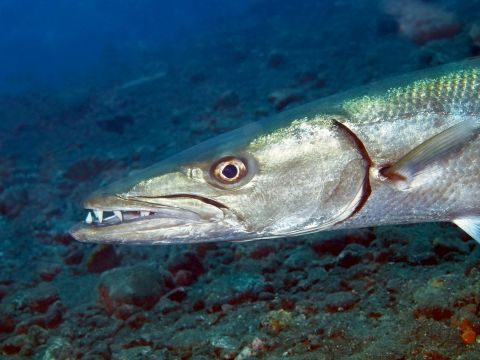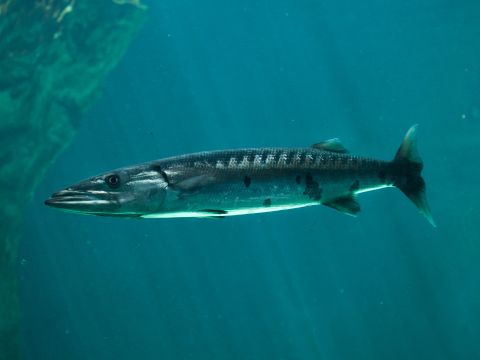Today, we embark on an exhilarating journey to explore one of the ocean’s most fearsome predators – the barracuda. Known for its powerful speed, sharp teeth, and stunning silver appearance, the barracuda is a formidable sight beneath the waves. However, what truly sets this creature apart is its jaw-dropping record – the title of the biggest barracuda ever caught.
In this article, we’ll present the compelling facts and figures surrounding this colossal catch, providing an insightful look into the world of barracudas and the thrill of angling for these remarkable fish. So, fasten your seatbelts as we unravel the tale of the largest barracuda ever recorded!

Table of Contents
What is a barracuda?
A barracuda is a predatory fish belonging to the Sphyraenidae family, found in warm, tropical, and subtropical waters across the globe. These fierce marine predators are known for their streamlined, elongated bodies, equipped with razor-sharp teeth, making them one of the most formidable hunters in the ocean. With a reputation as aggressive and fast swimmers, barracudas are at the top of the food chain in their aquatic habitats.
Physical characteristics
Barracudas typically have a silvery or grayish appearance with dark markings on their upper bodies, aiding in camouflage while hunting. They possess a long, cylindrical shape, which allows them to reach impressive speeds in pursuit of prey. These fish can grow to various sizes, with some species reaching lengths of up to six feet or more.
Feeding habits
As carnivorous predators, barracudas have a diverse diet, primarily consisting of small fish like anchovies, herrings, and mullets. They are ambush predators, often lying in wait near reefs, drop-offs, or underwater structures and using their incredible speed to strike unsuspecting prey.
Range and habitat
Barracudas inhabit many marine environments, including coral reefs, coastal waters, and open seas. They are commonly found in the Atlantic, Indian, Pacific Oceans, the Caribbean Sea, and the Gulf of Mexico. These fish prefer warm waters, typically 25 to 30 degrees Celsius (77 to 86 degrees Fahrenheit).
Behavior and threats
Though barracudas are generally solitary hunters, they can occasionally be seen in loose groups, especially around areas teeming with food sources. While they rarely threaten humans, barracuda attacks have been reported, often involving the fish mistaking shiny objects or dangling jewelry for prey.
Importance in ecosystems
Barracudas play a vital role in maintaining the balance of marine ecosystems. As apex predators, they help control the population of smaller fish, preventing them from overwhelming their environments. Additionally, barracudas prey on larger predators, contributing to the intricate web of life beneath the ocean’s surface.

What is the average size of barracudas?
Barracudas, renowned for their impressive size and fearsome appearance, exhibit considerable variability in their dimensions depending on the species and the environment in which they reside. On average, barracudas range from relatively modest lengths to strikingly large proportions. Let’s delve into the typical size specifications of these powerful predators.
The average size of barracudas can vary significantly across species. Generally, the smaller species, such as the pick handle Barracuda (Sphyraena jello) and Guinean Barracuda (Sphyraena afra), measure around 1.5 to 3 feet (45 to 90 centimeters) in length. On the other hand, larger species like the Great Barracuda (Sphyraena barracuda) can grow to formidable lengths, often reaching 4 to 6 feet (120 to 180 centimeters).
What is the largest barracuda ever caught?
In the world of angling, an astonishing record is held by a massive barracuda. On July 8th, 2019, in the waters off the coast of Fort Dodge, Florida, American fisherman Arin Long was stunned when he reeled in what would become the biggest barracuda ever caught!
Weighing in at a whopping 78 pounds (35.3 kilograms) and measuring a staggering 5 feet 8 inches (176 centimeters), this colossal catch beat the previous record previously held by an angler in Texas, which weighed 68 pounds (30.8 kilograms).
After reeling in his impressive haul, Long had to enlist the help of several onlookers to lift the massive fish onto shore. He then proudly posed for a photo with the monstrous catch, and his epic tale quickly gained traction on social media.
While Long’s feat is certainly an incredible accomplishment, it serves as a testament to the awesome power of these remarkable fish. As one of nature’s most intimidating predators, barracudas are known for their impressive size and strength, making them a thrilling challenge for any angler.
So, if you’re lucky enough to find yourself in the waters near Fort Dodge, keep an eye out – who knows, you are the one to best Arin Long’s record!

How to catch a barracuda
Catching a barracuda can be an exhilarating challenge for anglers across the world. With their formidable strength and lightning-fast speed, these marine predators will test any fisherman’s mettle! To help you get started, here are a few tips and tricks for catching barracudas:
Equipment
Since barracudas possess tremendous strength, it’s important to use appropriate tackle when angling for these fish. Your best bet is to select a sturdy rod-and-reel combo with a fast action, matched with a strong braided line in the 20-40 pound (9-18 kilogram) range. You’ll also want heavy-duty hooks and lures to stand up to the barracuda’s powerful jaws.
Set-up and bait
Since these predators are ambush hunters, you’ll want to set up your tackle in areas where they can easily hide and surprise their prey. This could include deep channels, rocky outcrops, coral reefs, or even manmade structures like sunken boats or pilings. To attract the barracudas ‘ attention, you’ll want live bait such as pilchards, herring, or mackerel.
Techniques
Once you’ve set up your tackle and bait, it’s time to start fishing! Cast your line out into the water and pay close attention to any signs of movement – a telltale sign of a barracuda nearby. If you’re lucky, the fish will strike, and the fight is on! When battling a barracuda, you’ll want to use steady pressure to tire it out and avoid any sudden jerks that could break your line.
As with fishing, patience and practice are key when angling for barracudas. With the right equipment and techniques, you should be able to catch your first barracuda in no time. So, grab your tackle and head out into the waters – who knows what kind of adventure! Good luck!
Where are barracudas found?
Barracudas are found in warm, tropical waters around the world. These fierce predators inhabit many marine environments, from coral reefs to coastal areas and open seas. They can be commonly found in the Atlantic, Indian, and Pacific Oceans, the Caribbean Sea, and the Gulf of Mexico. Barracudas have also been spotted in the Mediterranean and Red Seas.
In addition to their range, barracudas are found at various depths, from shallow coastal waters to deeper offshore locations. Though they prefer murky areas where they can easily hide from prey, they can likely be encountered in almost any marine habitat. So, if you plan on fishing for barracudas, you’ll find them wherever the waters are warm!
The presence of barracudas in an area usually indicates a healthy marine environment. As apex predators, they help maintain balance in their ecosystems by controlling the population sizes of smaller fish and serving as prey for larger animals. In this way, they keep oceans and other aquatic habitats flourishing – a reminder of these remarkable creatures’ invaluable contributions to the life beneath the ocean’s surface.
Can you eat barracuda?
Although barracudas have razor-sharp teeth and powerful jaws, they are not considered a threat to humans. There has never been a recorded instance of an unprovoked attack on a human by a barracuda.
If you encounter one in the wild, it’s best to avoid handling them. Barracudas are strong and wild animals, so respecting their space and leaving them alone is important. It should also be noted that barracudas can become aggressive if they feel threatened or if you try to feed them, so it’s best not to do either.
In terms of eating barracuda, the answer is a bit more complicated. While they are considered delicious and nutritious fish, barracudas can contain levels of ciguatera toxin that can cause serious health issues in humans if eaten. It’s important only to consume barracuda caught in safe, clean waters and thoroughly cooked before eating.
Overall, barracudas are an intriguing species with fascinating behaviors and fascinating appearances. And while they can be a thrilling catch for experienced anglers, it’s important to take the proper safety precautions when fishing for or handling these powerful predators!
How can people help conserve barracudas?
Barracudas are an integral part of marine ecosystems. Yet, human activities such as overfishing and habitat destruction often threaten them. To help conserve these powerful predators, there are a few things that people can do:
Support sustainable fisheries
One of the easiest ways to help conserve barracudas is to buy seafood from sustainable sources. By ensuring that your seafood comes from fisheries that practice responsible fishing methods, you can help preserve the barracuda populations.
Reduce pollution
Pollution from runoff and oil spills can devastate marine life, including barracudas. To help prevent this, try to reduce your use of plastic materials and dispose of any hazardous waste properly. Additionally, you can support organizations working to protect oceans from pollution.
Engage in conservation activities
Engaging in conservation activities is a great way to help barracudas and other marine species. This could be as simple as joining a beach cleanup or volunteering with an organization dedicated to ocean conservation. You can also spread the word about the importance of conserving barracudas by talking to your friends and family about the threats they face and how to protect them.
By following these simple steps, we can all help to ensure that barracudas remain a part of our world’s marine ecosystems for generations to come. It’s up to us to be their guardians – let’s do our best!









































